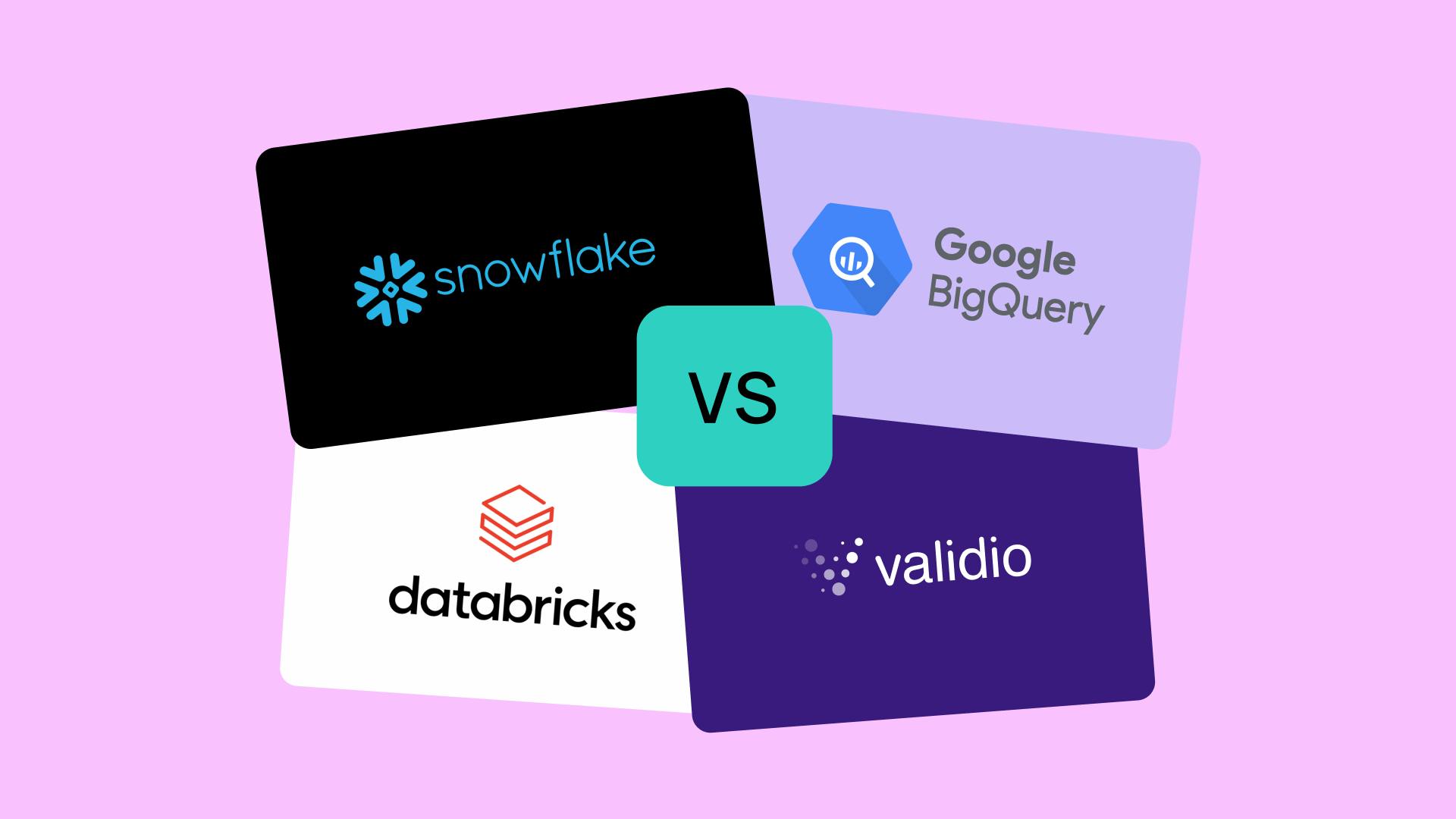When tackling data quality through automated anomaly detection, picking the right tool is a cornerstone for securing the best outcomes with minimal complexity. Validio has a history of being a leader in automated anomaly detection, accurately identifying irregularities within both data warehouses and streaming data. Integration with leading data platforms such as Snowflake, BigQuery, and Databricks is streamlined, making a significant move towards effortless anomaly detection a reality for everyone.
These platforms, widely used for their solid data warehousing and analytics capabilities, complement Validio perfectly. Having recently equipped their warehouses with functionality for anomaly detection in time-series data, we’re eager to explore how these offerings stack up against Validio’s algorithms.
Anomaly detection in Snowflake
Snowflake delivers performant anomaly detection capabilities by utilizing advanced algorithms tailored for complex time-series data. Its platform excels in processing and analyzing time-series data by integrating exogenous variables such as external events and weather patterns, enhancing prediction accuracy. Despite its advanced features, Snowflake's approach can be somewhat rigid and cumbersome, affecting user efficiency and flexibility.
Challenges
- Model Management: Snowflake’s anomaly detection models are immutable, meaning that any update requires a full retrain of the model. This process adds significant operational overhead and delays, as every new data point necessitates re-running the entire model. Validio addresses this by leveraging online model updates which automatically update the model with the latest incoming data points.
- Scalability and Cost: Snowflake is capable of managing a large number of time series simultaneously, making it suitable for extensive datasets. However, this capability requires careful consideration of cost and warehouse sizes. Efficiently handling numerous time series may demand using larger warehouses like Standard XL or even Snowpark-optimized XL which can impact costs and need management strategies for warehouse configurations.
- Ease of Use: Snowflake’s end-to-end anomaly detection process involves multiple steps and often requires additional tools like Snowsight for visualization and incident management. This can complicate the workflow and make real-time monitoring more cumbersome. Validio simplifies this by integrating visualization and alerting tools directly into its platform. This offers a single, user-friendly interface to identify, resolve, and prevent data quality issues.
Conclusion
Snowflake provides a robust foundation for anomaly detection with its advanced algorithms and capability to handle complex time-series data. However, Validio’s user-centric UI design, low-code aspect, and integrated features present a more efficient and accessible solution for businesses seeking a seamless experience.
Anomaly detection in Google BigQuery
Google BigQuery has strong capabilities to manage and analyze large-scale, complex time-series data using advanced algorithms such as ARIMA_PLUS and ARIMA_PLUS_XREG. It is highly effective for handling extensive datasets and complex seasonal patterns, making it a powerful tool for large-scale anomaly detection.
Challenges
- Operational Complexity: BigQuery, similar to Snowflake, requires full retraining of models with each new data set. This process can be complex and time-consuming, involving manual query management and extensive setup. Validio simplifies this by providing real-time dynamic updates, allowing for quicker adjustments and more efficient model management.
- Cost and Resource Management: Handling large datasets in BigQuery necessitates careful planning regarding query execution time and resource allocation. The need for meticulous resource management can increase costs and operational complexity. Validio’s solution, in contrast, scales effortlessly and is designed to minimize resource demands, making it more cost-effective and easier to manage.
- User Experience: BigQuery’s integration with visualization tools like Looker is beneficial but often requires additional setup and custom coding for alerting. Validio offers a more integrated approach, providing built-in visualization and alerting features that work out of the box, no extra steps required. This means you can focus more on insights and less on setup.
Conclusion
In conclusion, Google BigQuery provides powerful anomaly detection capabilities through its built-in function, which uses advanced ARIMA-based models to handle a wide range of time-series data scenarios. It supports multivariate analysis, handles missing data and irregular time intervals, and can detect seasonal patterns and holiday effects. However, users need to plan for resource costs and manage model retraining manually, making it more suitable for those who are comfortable with hands-on model management and optimization.
Anomaly detection in Databricks
Databricks offers a highly flexible suite of anomaly detection tools designed for users with advanced machine learning knowledge. Their platform allows for extensive customization, leveraging libraries like Kakapo and PyOD for outlier detection, and tools like MLflow for model tracking and Hyperopt for hyperparameter tuning. This flexibility supports both supervised and unsupervised anomaly detection, enabling users to tailor their models to specific needs and combine multiple models for robust predictions.
Challenges
- Complexity: Databricks demands significant machine learning knowledge and expertise to effectively utilize its tools and build custom models. This requirement makes it less accessible to users without specialized skills. Validio, on the other hand, is designed to be user-friendly, enabling quick deployment and management of anomaly detection models without requiring advanced technical expertise.
- Manual Effort: Users must manually manage and evaluate models in Databricks, which involves tracking performance, adjusting parameters, and handling various aspects of model maintenance. This manual approach can be labor-intensive and prone to errors. Validio automates most of the setup, offering recommended validation setup based on your data. Our anomaly detection models also use machine learning to auto-adjust to your data patterns—no manual configuration needed.
- Resource Intensity: Training and managing models in Databricks can be resource-intensive, requiring significant computational power and infrastructure. Validio’s processing engine is written in Rust and all algorithm implementations are optimized for efficiency. By only querying metrics and aggregate values, the need to read raw data is minimized. This provides predictable performance with lower resource requirements and reduced operational costs.
Conclusion
Databricks is a powerful tool for those with the expertise to leverage its capabilities, offering extensive customization and flexibility. However, Validio’s automated features, ease of use, and efficiency make it a more practical choice for businesses seeking rapid deployment and streamlined management of anomaly detection.
Final thoughts
It's clear that Snowflake, Google BigQuery, and Databricks have carved their niches, offering unique strengths for specific use cases in anomaly detection. From processing complex time-series data with advanced algorithms to providing extensive customization for machine learning experts, each has its space where it shines. However, when considering the broader spectrum of needs—especially for businesses prioritizing data quality management with a focus on usability and effectiveness—Validio stands out.
Validio streamlines anomaly detection with a user-friendly platform, balancing powerful automation with simplicity for effective data quality management without relying on coding or technical expertise.
Setting up anomaly detection in your DWH?
See our guide on how to get started.



